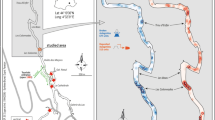Abstract
Tektites are bodies of natural glass of limited size and of typical shape and sculpturing. They occur in relatively large numbers in limited strewn-fields, each formed by a single event in the geological past. Three (perhaps four) tektite fields are known, all of different age. Perhaps only the youngest-the indoaustralian strewn-field, reaching from Thailand to Tasmania — in its original extension, the others having suffered from erosion.
Many tektites from Indonesia and all from Australia show two periods of melting, which must be regarded as proof of extraterrestrial origin. These secondary forms with rims or flanges, developed by ablation in the earth's atmosphere, probably depend upon a low entry angle and are therefore only represented from certain regions.
Tektites consist for about 70–80% of silica, show fluidal texture, no traces of crystallization and a remarkably low water content. From a chemical point of view they resemble certain terrestrial rocks more than true meteorites. Probably they represent molten parts from the moon's surface, which were thrown into space after the impact of large meteorites.
Similar content being viewed by others
References
Adams, E. W. and Huffaker, R. M.: 1962, Nature 195, 681–684.
Baker, G.: 1959, Tektites. Man. Nat. Mus. Victoria no. 23, 1–313 (Extensive list of literature).
Baker, G.: 1962, Chemie der Erde 21, 269–320.
Barnes, V. E.: 1940, Mio. of Texas Publ. Nr. 3945.
Barnes, V. E.: 1961, Scient. American 205, no. 5.
Barnes, V. E. and Pitakpaivan, K.: 1962, Proc. Nat. Ac. Sci. 48, 947–955.
Beyer, H. O.: 1961–1962, Philippine Tektites I, II, University ofManila, Philippines.
Chao, E. C. T. and Adler, I.: 1962, Science 135, 97–98.
Chapman, R. D.: 1960, Nature 188, 353–355.
Clarke, R. S. and Henderson, E. P.: 1961, Georgia Mineral News Letter 14, 90–114.
Friedman, I.: 1955, Bull Geol. Soc. Amer. 66, 1562.
Hanus, F.: 1928, Acad. Sci. Bohème 37.
Hawkins, G. S.: 1963, J. Geophys. Res. 68, 895–910.
Von Koenigswald, G. H. R.: 1957, Proc. Kon. Ned. Acad. Wet., Amsterdam, Ser. B, 60.
Von Koenigswald, G. H. R.: 1960, Proc. Kon. Ned. Acad. Wet., Amsterdam, Ser. B, 63.
Von Koenigswald, G. H. R.: 1963, Proc. Kon. Ned. Acad. Wet., Amsterdam, Ser. B, 66.
Urey, H. C.: 1957, Nature 179, 556.
Varzavsky, C. M.: 1958, Geochim. Cosmochim. Acta 14, 291.
Wing Easton, N.: 1921, Verh. Kon. Acad. Wet., Amsterdam, sectie 2, 22.
Zähringer, J. and Gentner, W.: 1963, Nature 199, 583.
Author information
Authors and Affiliations
Rights and permissions
About this article
Cite this article
Von Koenigswald, G.H.R. The problem of tektites. Space Sci Rev 3, 433–446 (1964). https://doi.org/10.1007/BF00230519
Received:
Issue Date:
DOI: https://doi.org/10.1007/BF00230519




